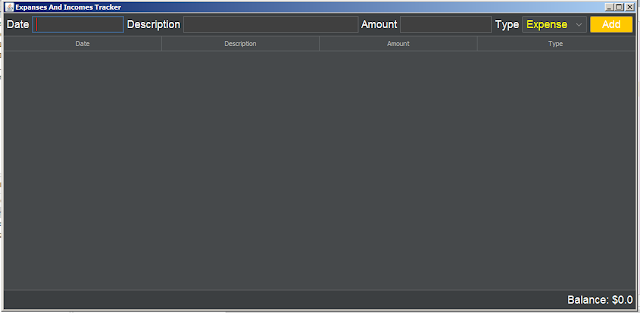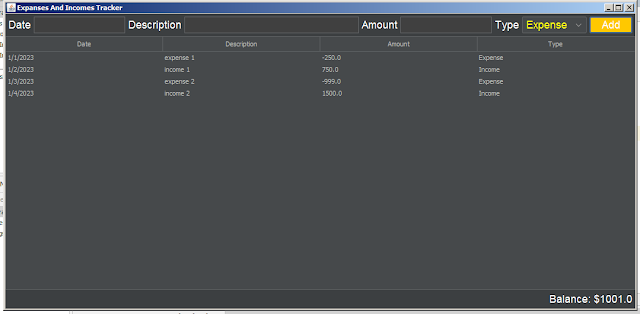How To Make an Expenses And Incomes Tracker Project Using NetBeans
Project Source Code:
1 - Create the ExpenseIncomeEntry Class:
package expense_income_tracker;
/**
*
* @author 1BestCsharp
*/
/*
* ExpenseIncomeEntry represents a single entry for expenses and incomes.
* Each entry contains a date, description, amount, and type (expense or income).
*/
public class ExpenseIncomeEntry {
private String date;
private String description;
private double amount;
private String type; // The type of the entry (expense or income).
public ExpenseIncomeEntry(String date, String description, double amount, String type)
{
this.date = date;
this.description = description;
this.amount = amount;
this.type = type;
}
public String getDate(){ return date;}
public String getDescription(){ return description;}
public double getAmount(){ return amount;}
public String getType(){ return type;}
}
2 - Create the ExpenseIncomeTableModel Class:
package expense_income_tracker;
import java.util.List;
import java.util.ArrayList;
import javax.swing.table.AbstractTableModel;
/**
*
* @author 1BestCsharp
*/
public class ExpenseIncomeTableModel extends AbstractTableModel {
// List to store the entries (rows) in the table
private final List<ExpenseIncomeEntry> entries;
// Column names for the table
private final String[] columnNames = {"Date","Description","Amount","Type"};
/**
* Constructor to initialize the table model.
*/
public ExpenseIncomeTableModel(){
entries = new ArrayList<>();
}
/**
* Add a new entry to the table.
*
* @param entry The expense or income entry to add.
*/
public void addEntry(ExpenseIncomeEntry entry){
entries.add(entry);
// Notify the table that a new row has been inserted
fireTableRowsInserted(entries.size()-1, entries.size()-1);
}
@Override
public int getRowCount() { return entries.size(); }
@Override
public int getColumnCount() { return columnNames.length;}
@Override
public String getColumnName(int column){ return columnNames[column]; }
@Override
public Object getValueAt(int rowIndex, int columnIndex) {
ExpenseIncomeEntry entry = entries.get(rowIndex);
// Return the value for the cell based on the column index
switch(columnIndex){
case 0: return entry.getDate();
case 1: return entry.getDescription();
case 2: return entry.getAmount();
case 3: return entry.getType();
default: return null;
}
}
}
3 - Create the ExpensesIncomesTracker Class (JFrame):
package expense_income_tracker;
import com.formdev.flatlaf.FlatDarkLaf;
import javax.swing.*;
import java.awt.*;
/**
*
* @author 1BestCsharp
*/
// The ExpensesIncomesTracker class extends JFrame to create the main application window.
public class ExpensesIncomesTracker extends JFrame {
private final ExpenseIncomeTableModel tableModel;
private final JTable table;
private final JTextField dateField;
private final JTextField descriptionField;
private final JTextField amountField;
private final JComboBox<String> typeCombobox;
private final JButton addButton;
private final JLabel balanceLabel;
private double balance; // The current balance based on the added expenses and incomes.
// Constructor to initialize the application and set up the form.
public ExpensesIncomesTracker(){
try{
// Apply the FlatDarkLaf look and feel for a modern and flat appearance.
UIManager.setLookAndFeel(new FlatDarkLaf());
}
catch(Exception ex){
System.err.println("Failed to Set FlatDarkLaf LookAndFeel");
}
// Custom color schemes for specific Swing components.
UIManager.put("TextField.foreground", Color.WHITE);
UIManager.put("TextField.background", Color.DARK_GRAY);
UIManager.put("TextField.caretForeground", Color.RED);
UIManager.put("ComboBox.foreground", Color.YELLOW);
UIManager.put("ComboBox.selectionForeground", Color.WHITE);
UIManager.put("ComboBox.selectionBackground", Color.BLACK);
UIManager.put("Button.foreground", Color.WHITE);
UIManager.put("Button.background", Color.ORANGE);
UIManager.put("Label.foreground", Color.WHITE);
// Set the default font for the entire application
Font customFont = new Font("Arial", Font.PLAIN, 18);
UIManager.put("Label.font", customFont);
UIManager.put("TextField.font", customFont);
UIManager.put("ComboBox.font", customFont);
UIManager.put("Button.font", customFont);
// Initialize the table model and balance variable.
balance = 0.0;
tableModel = new ExpenseIncomeTableModel();
// Create a JTable and set up a scroll pane to display the data.
table = new JTable(tableModel);
JScrollPane scrollPane = new JScrollPane(table);
table.setFillsViewportHeight(true);
// Create input fields and components for adding new entries.
dateField = new JTextField(10);
descriptionField = new JTextField(20);
amountField = new JTextField(10);
typeCombobox = new JComboBox<>(new String[]{"Expense","Income"});
// Attach an ActionListener to the "Add" button to handle new entry addition.
addButton = new JButton("Add");
addButton.addActionListener(e -> addEntry());
balanceLabel = new JLabel("Balance: $" + balance);
// Create input panel to arrange input components.
JPanel inputPanel = new JPanel();
inputPanel.add(new JLabel("Date"));
inputPanel.add(dateField);
inputPanel.add(new JLabel("Description"));
inputPanel.add(descriptionField);
inputPanel.add(new JLabel("Amount"));
inputPanel.add(amountField);
inputPanel.add(new JLabel("Type"));
inputPanel.add(typeCombobox);
inputPanel.add(addButton);
// Create bottom panel to display the balance.
JPanel bottomPanel = new JPanel(new FlowLayout(FlowLayout.RIGHT));
bottomPanel.add(balanceLabel);
setLayout(new BorderLayout());
// Set the layout of the main frame and add components to appropriate positions.
add(inputPanel, BorderLayout.NORTH);
add(scrollPane, BorderLayout.CENTER);
add(bottomPanel, BorderLayout.SOUTH);
// Set the title, default close operation, and visibility of the main frame.
setTitle("Expanses And Incomes Tracker");
setDefaultCloseOperation(JFrame.EXIT_ON_CLOSE);
pack();
setVisible(true);
}
// Method to handle adding new entries to the table.
private void addEntry()
{
// Get input values from input fields.
String date = dateField.getText();
String description = descriptionField.getText();
String amountStr = amountField.getText();
String type = (String)typeCombobox.getSelectedItem();
double amount;
// Validate input values.
// you can the description and date to the validation
if(amountStr.isEmpty())
{
JOptionPane.showMessageDialog(this, "Enter the Amount", "Error", JOptionPane.ERROR_MESSAGE);
return;
}
try
{
amount = Double.parseDouble(amountStr);
}
catch(NumberFormatException ex)
{
JOptionPane.showMessageDialog(this, "Invalid Amount Format", "Error", JOptionPane.ERROR_MESSAGE);
return;
}
// Convert expenses to negative values.
if(type.equals("Expense"))
{
amount *= -1;
}
// Create a new entry and add it to the table.
ExpenseIncomeEntry entry = new ExpenseIncomeEntry(date, description, amount, type);
tableModel.addEntry(entry);
// Update the balance and display the new balance.
balance += amount;
balanceLabel.setText("Balance: $"+balance);
// Clear input fields for the next entry.
clearInputFields();
}
// Method to clear input fields.
private void clearInputFields()
{
dateField.setText("");
descriptionField.setText("");
amountField.setText("");
typeCombobox.setSelectedIndex(0);
}
}
4 - Create the Main Class:
package expense_income_tracker;
/**
*
* @author 1BestCsharp
*/
public class Expense_Income_Tracker {
/**
* @param args the command line arguments
*/
public static void main(String[] args) {
new ExpensesIncomesTracker().setLocationRelativeTo(null);
}
}
////// OUTPUT :
More Java Projects:
Download Projects Source Code


